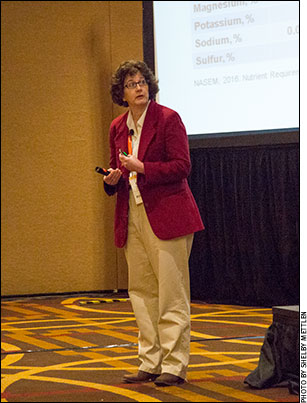Know Your Requirements
Proper mineral nutrition is important to your cattle operation.
If you don’t first address the energy and protein requirements of your cattle, minerals aren’t going to matter, Beth Kegley, professor of animal science at the University of Arkansas, told her audience at the Cattle Industry Convention Feb. 1. Kegley spoke as part of the 24th annual Cattlemen’s College® in Nashville, Tenn.

“The digestive tracts of these animals are never 100% efficient,” said Beth Kegley, professor of animal science at the University of Arkansas. “They’re never absorbing 100% of what you feed them. That percentage varies dramatically based on the chemical form of the mineral.”
One of the most complicating factors surrounding mineral nutrition in cattle production today is that mineral requirements at each stage of the production chain can be vague.
“We don’t really know what we don’t know,” she said. At a certain level, it will be apparent in the animal’s appearance that it isn’t doing well. Otherwise, and in most cases, the animal simply won’t be functioning to its full potential. “You’ll be leaving something behind.”
As with other nutritional requirements, cattle have different mineral needs at different stages of the production cycle. Growing cattle have different requirements than gestating cows.
Mineral requirements can also vary by breed of cattle, she said. “The scientific literature says Simmental and Charolais have a greater copper requirement than Angus.” Continental and British breeds have a greater susceptibility to grass tetany than Zebu breeds like Brahman cattle.
Efficiency
“The digestive tracts of these animals are never 100% efficient,” she noted. “They’re never absorbing 100% of what you feed them. That percentage varies dramatically based on the chemical form of the mineral.”
Kegley listed several factors that can alter the mineral content of forages.
Other minerals in the diet play a part in the efficiency and absorption of each mineral.
“What we worry about most in the beef cattle industry is that there can be a negative effect of molybdenum and sulfur on how much copper is absorbed,” she noted.
Mineral content varies due to both soil type and forage type, application of fertilizer and pesticides, soil pH, and plant maturity.
Kegley encouraged producers to educate themselves and build some knowledge of their individual situations.
“Talk to your neighbors, talk to your local extension agents,” she said. “They will know regional generalities for what minerals are potentially deficient.”
Editor’s Note: This article was written as part of Angus Media’s coverage of the 2017 Cattle Industry Convention. For further coverage, watch for future issues of the Angus Beef Bulletin or visit www.angus.media.







